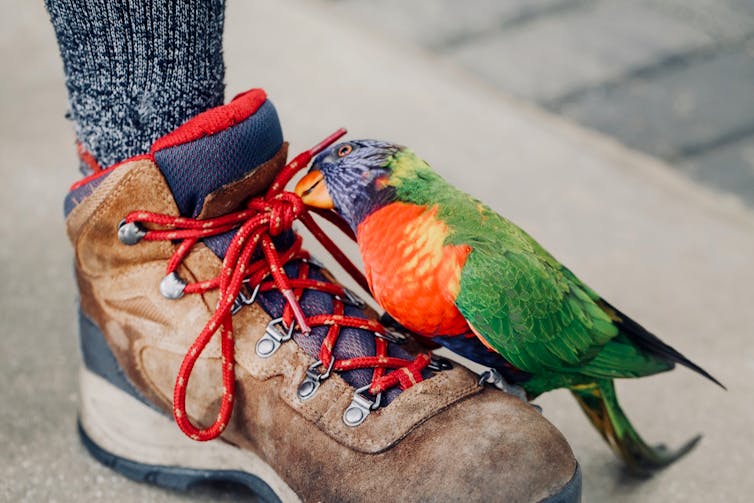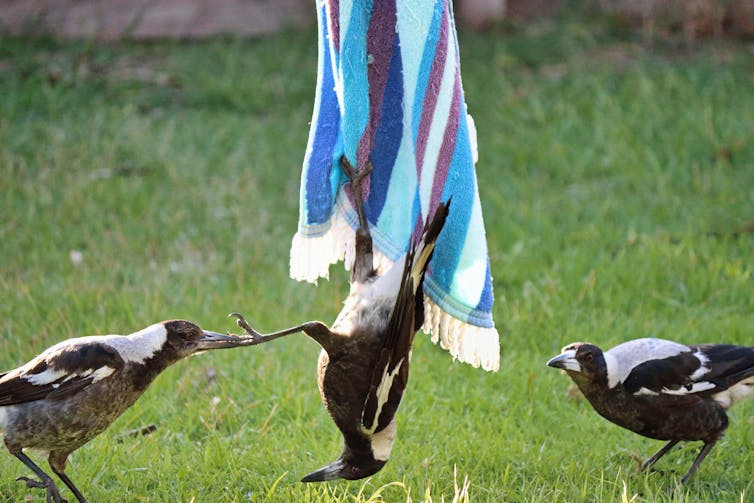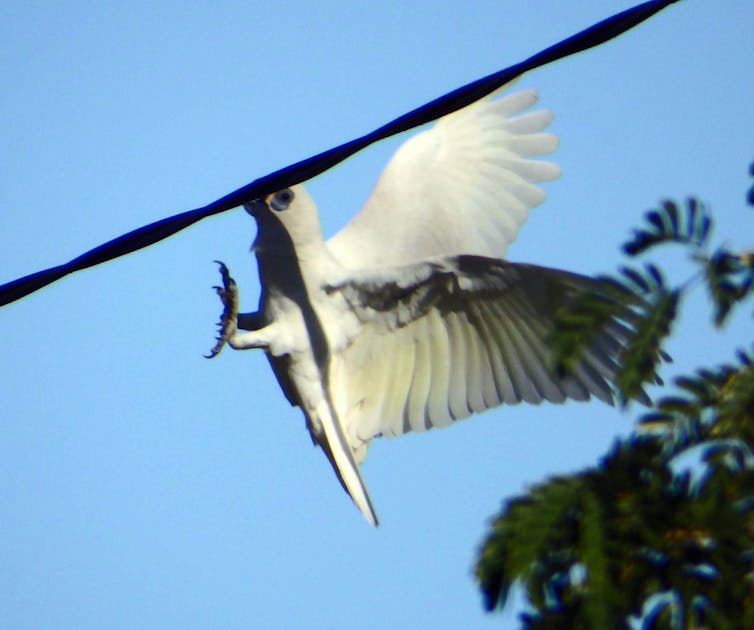Tag Archives for biggest
The Biggest Tornadoes
Biggest Volcanic Eruptions
Birds that play with others have the biggest brains – and the same may go for humans

Shutterstock
Gisela Kaplan, University of New England
Have you ever seen magpies play-fighting with one another, or rolling around in high spirits? Or an apostlebird running at full speed with a stick in its beak, chased by a troop of other apostlebirds? Well, such play behaviour may be associated with a larger brain and a longer life.
For the past 50 years, international animal cognition research has often related the use of tools such as rocks and sticks to cognitive abilities in animals. But my research on Australian native birds, published in Scientific Reports, casts doubt on long-held assumptions about the links between large brains and tool use.
My study found no significant association between tool use and brain mass. However, very clear differences in relative brain mass emerged when birds showing play behaviour were compared to those that didn’t play. In particular, birds that played with others (known as social play) had the largest brain mass, relative to body size, and even the longest lifespans.
The results suggest play behaviour may be an important driver in the evolution of large brains in a number of species, including humans.

The Magpie Whisperer
Tool use in birds
Tool use has been studied in a wider range of species than play behaviour. Some internationally famous Australian examples include:
-
the black-breasted buzzard releasing rocks from their beaks to crack emu eggs
-
the black kite picking up burning embers and twigs and dropping them on dry grass areas to start a fire. The bird then feasts on fleeing or injured insects and vertebrates
-
palm cockatoos that drum with a stick.
According to a classic theory known as the “technical intelligence hypothesis”, humans and other animals developed large brains because circumstances forced them into ever more sophisticated tool use.
Read more:
Bird-brained and brilliant: Australia’s avians are smarter than you think
So what is bird play?
Play behaviour usually occurs in juveniles but in some species, such as little corellas or galahs, it extends into adulthood. Play behaviour occurs in species which tend to have long juvenile periods, long-term support from parents and which grow up in stable social groups.
Play behaviour is usually subdivided into three categories: solo play, object play and social play.
Solo play: this may involve a single bird running, skipping, jumping, ducking, rolling, hanging, swinging, dancing, sliding and snow-romping. Solo play is the most widespread form of play, common among honeyeaters, parrots, magpies, currawongs, butcherbirds, riflebirds and some pigeon species.
The best acrobat among the pigeons is probably the topknot pigeon, but rainbow lorikeets are also known to love swinging.
Object play: this involves objects of any kind, including sticks, stones and small household items. Object players might carry a stick or stone or even just a leaf around, drop it, then pick it up again and run with it.
Object players are not as numerous as solo players but still widespread across species. Click here to read a lovely description of a kookaburra absorbed in playing with a stone.
Social play: involves two or more individuals. Social play is so far the rarest category. It might involve one bird holding an object in its beak and the others chasing it. Published cases are largely limited to parrots and corvids, and are known in magpies and ravens.
Read more:
What Australian birds can teach us about choosing a partner and making it last
White-winged choughs are known to play a game in which two youngsters simultaneously grab a small stick or a bunch of grass, then each tries to wrest it from the other.
It’s important to note that social players are also solo and object players, but solo or object players may not be social players. The latter is considered a more complex form of play.
It turns out these categories are meaningful when used to analyse a potential link to brain mass. Information on brain weight/mass in Australian birds has been available only since an important study in 2014. It identified brain volumes and body sizes of all Australian bird species, enabling researchers to link these biological data to behavioural data.

Gisela Kaplan
A surprising link
My study involved 77 native Australian bird species for which full data sets were available. The results were more than surprising. In the samples used, tool use seems to confer no advantage whatsoever in terms of brain size or life expectancy: no matter whether a species showed tool using or not, relative brain masses were not different. However the results showed, rather dramatically, that brain size and forms of play are associated.
Social players, versus other players and versus non-players showed significantly different average brain sizes in each category:
-
non players have the lowest average brain size
-
solo players had slightly larger brains than non-players
-
object players had larger brains again
-
social players had by far the largest average brain size relative to body weight.
These results are by no means confined to parrots, but are found in songbirds and other orders. Whether this holds for birds globally is not yet known. However, since parrots and songbirds first evolved in Australia, then spread to the rest of the world, the results may indeed hold for birds outside Australia. More research will be needed.
Read more:
Magpies can form friendships with people – here’s how
Which came first – play resulting in large brains or large brains triggering play behaviour – is not known. But whichever way one looks at it, playing socially or even just playing at all, is related to a bigger brain and a long life.
So what does all this mean for human brain evolution? It may be a long shot, but the stages of development in humans and birds seem to have some similarities and this may be significant.
Offspring in humans, as in great apes and other primates, also develop slowly, have protracted childhoods and play extensively as do a surprising number of Australian native birds. It may mean playing together offers more than just passing the time. It could be an evolutionary driver for intelligence, and even for a long life.![]()
Gisela Kaplan, Emeritus Professor in Animal Behaviour, University of New England
This article is republished from The Conversation under a Creative Commons license. Read the original article.
Australia’s biggest emitters opt to ‘wait and see’ over Emissions Reduction Fund
Jayanthi Kumarasiri, Swinburne University of Technology and Nava Subramaniam, RMIT University
Many of Australia’s most carbon-intensive companies are either not participating in the federal government’s flagship Emissions Reduction Fund (ERF), or are adopting a wait-and-see approach, according to our survey of senior executives. ![]()
The ERF, introduced in 2014 after the repeal of the carbon tax, is the central component in the government’s policy to reduce greenhouse emissions. Companies can bid for money from an overall fund of A$2.55 billion, to invest in low-carbon technologies and initiatives. Participation is voluntary.
Five ERF auctions have been held, awarding A$2.23 billion so far. However, participation by high-emitting companies has been persistently low.
Some of the funded projects are likely to deliver useful emissions cuts in areas such as forestry, landfill and waste management. But the scheme is yet to reduce emissions reductions in key sectors of the economy such as industry and electricity generation. Our survey underlines concerns that the scheme is not attracting the biggest emitters.
Asking the questions
Our research, titled the Australian Emission Reduction Fund Survey and produced in collaboration with the Carbon Market Institute, was conducted in two rounds.
First, in 2015, we surveyed executives from high-emitting companies in sectors including mining, manufacturing, energy and transport. Then, in 2016, we surveyed executives from firms that had successfully registered carbon-reduction projects under the ERF. Survey respondents represented a broad range of positions, including managing directors, general managers, senior carbon advisers, heads of environmental markets and strategy, and chief executives.
The first-round survey, which was conducted before the first ERF auction and featured 68 participants, showed that 58% of companies planned to “wait and see” before engaging with the ERF. Another 34% said they did not intend to participate in the scheme at all.
One of the main reasons given for non-participation was the fact that the scheme is run as a reverse auction with no guarantee that bids will be successful. This makes it difficult to invest with certainty in the staffing and administration costs of running carbon-reduction projects. One participant told us:
…administrative costs do not make the ERF cost-effective for the scale of abatement opportunities available.
Respondents also told us that there was a lack of guidance on how to understand and participate in the ERF, and uncertainty over the rules of the safeguard mechanism that is meant to help drive demand for carbon credits.
Another issue that most participants highlighted is the inability to make a business case internally and to secure a relatively high price for emissions reductions. One manager emphasised:
Clearly a high price would assist in driving participation, but at the moment the package is not commercially attractive.
Furthermore, some respondents expressed concern over the perceived lack of a wide range of approved methods for cutting carbon. And almost all participants were concerned by policy uncertainty, with one saying:
…there is currently a lack of business certainty regarding carbon policy in the mid to long term.
ERF participants
The results of our second-round survey in 2016, featuring 33 participants from companies that have registered ERF projects, suggested that the financial risk for investors in ERF projects has reduced, having been awarded secure government contracts for delivering carbon reductions. Nevertheless, respondents highlighted a range of concerns about the scheme’s effectiveness.
All respondents highlighted the uncertainty of further funding after the initial A$2.55 billion allocation is exhausted. One participant suggested that the government’s forthcoming climate policy review, to be released this year, should specify exactly how much money the ERF will make available in the future.
Moreover, many respondents expressed doubts that contracts awarded in the ERF’s first four auctions will be completed. This has arisen partly because of a perceived lack of adequate measures to resolve potential disputes between project proponents and land holders. As one respondent told us:
The extent to which landholders understand the legal risks associated with projects is unclear.
Participants also presume that the policy’s safeguard mechanism lacks tight enough “baselines” – the emissions limits beyond which high emitters are required to buy carbon credits. Tough baselines would generate the necessary certainty of a future market, as one respondent explained:
The extent of uncertainty will also be affected by whether the safeguard mechanism is strengthened by reducing baselines, and therefore increasing the need to purchase offsets.
At the Paris climate summit in 2015, Australia pledged to cut carbon emissions by 26-28% below 2005 levels by 2030. But if the government’s flagship emissions-reductions policy is failing to involve the highest-emitting companies, that target begins to look very onerous indeed.
With the government’s major climate change policy review now underway, it is time for the government, other political parties and high-emitting companies to work together to design a climate policy that is economically efficient and environmentally effective. There is no time to “wait and see” when it comes to combating carbon emissions.
Jayanthi Kumarasiri, Lecturer in Accounting, Swinburne University of Technology and Nava Subramaniam, Professor of Accounting, RMIT University
This article was originally published on The Conversation. Read the original article.
Biggest Volcanic Eruption?
Kenya is building Africa’s biggest wind energy farm to generate a fifth of its power
Titan Beetle
The link below is to an article that takes a look at the Titan Beetle, the world’s biggest beetle.
For more visit:
http://www.inspirefusion.com/titan-beetle-worlds-biggest-beetle/
Updating the Website
I am constantly looking at ways to improve the kevinswilderness.com website and add new content to it. With the success of the Google Map that was added to the page dealing with my recent road trip, I have decided to add Google Maps wherever they would prove useful – such as for locations, track routes, etc.
The first part of the site getting an overhaul with Google Maps in mind, is the Barrington Tops page. I am also adding new content to the page as I go. The Barrington Tops page is one of the biggest pages on my site, so the process is taking a bit of time. You will also find the planned itinerary for my backpacking camping holiday here as well as I move along with it.
Visit the page at:
AUSTRALIA: ENVIRONMENTAL CRISIS – Massive Extinction Threat
Australia is facing an environmental crisis with a possible massive extinction threat due largely to human activities. The latest Red List by the International Union for the Conservation of Nature lists 788 plant and animal species as threatened in Australia, including 57 mammals, 44 birds, 38 reptiles and 48 amphibians.
The Tasmanian Devil is one of the most at risk Australian mammals, with a huge fall in numbers because of a deadly facial tumour disease.
The biggest threats to Australian species are introduced species including foxes, feral cats and cane toads.
The Red List has some 16 928 species on a global scale now facing extinction, with 3 246 of those species listed as critically endangered.
BELOW: A report dealing with the Red List
